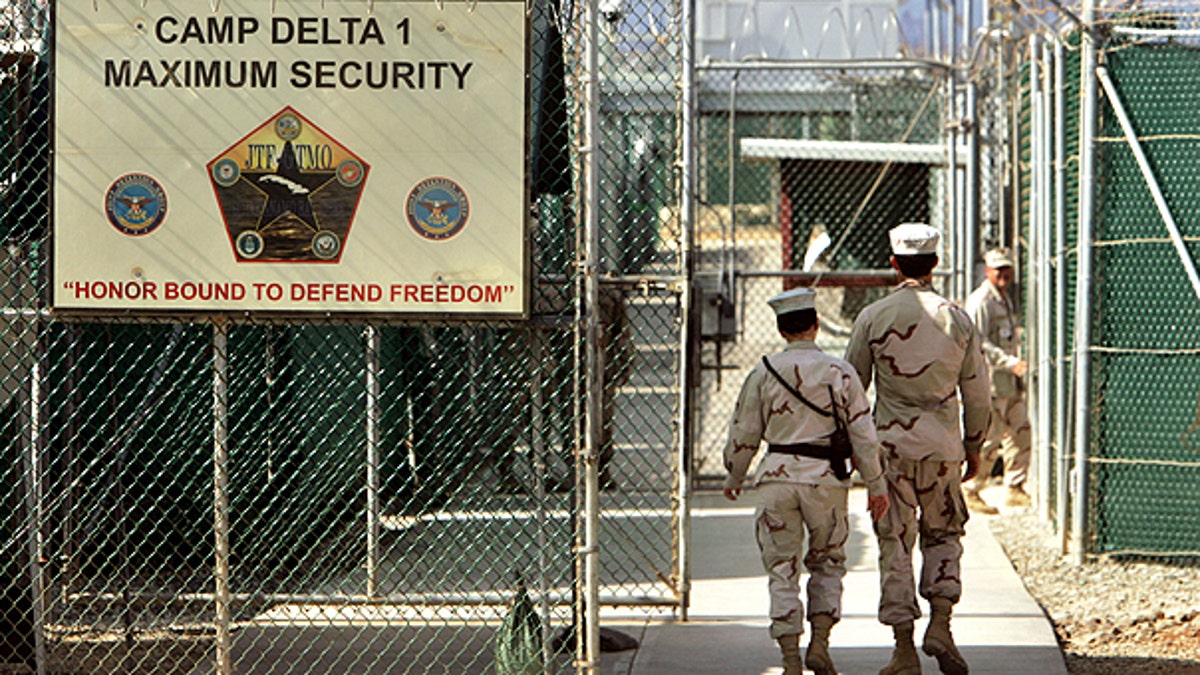
In this file photo from June 27, 2006, reviewed by a U.S. Department of Defense official, U.S. military guards walk within Camp Delta military-run prison, at the Guantanamo Bay U.S. Naval Base, Cuba. (AP)
The Obama administration, after being served a reminder that WikiLeaks continues to torment Western countries with its trove of secret documents, lashed out at the website and several news organizations for revealing previously undisclosed details about the Guantanamo Bay prison camp.
U.S. and European newspapers, using assessments first obtained by WikiLeaks, described an inconsistent and questionable process used to evaluate detainees suspected of terror ties. The New York Times, which published several reports on the documents, described cases where seemingly low-risk detainees were held at length, while prisoners who posed a legitimate threat were released.
Obama administration officials stressed that the documents may not reflect assessments that have since been made by President Obama's Guantanamo Review Task Force -- they said those files "have not been compromised to WikiLeaks."
However, the officials suggested the disclosure could hurt U.S. security and condemned the release.
"Both administrations have made the protection of American citizens the top priority and we are concerned that the disclosure of these documents could be damaging to those efforts," said Ambassador Daniel Fried, the Obama administration's special envoy on detainee issues, and Pentagon press secretary Geoff Morrell, in a written statement.
They stressed that WikiLeaks obtained the files "illegally" and called the decision by news organizations to publish them "unfortunate."
"These documents contain classified information about current and former GTMO detainees, and we strongly condemn the leaking of this sensitive information," they said.
The records contain details of the more than 700 detainee interrogations and evidence the U.S. had collected against these suspected terrorists, according to the media outlets.
It's not clear if the media outlets published the documents with the consent of WikiLeaks. The Times claimed WikiLeaks first obtained the documents, but that another source provided them to the newspaper.
The files -- know as Detainee Assessment Briefs, or DABs -- describe the intelligence value of the detainees and whether they would be a threat to the U.S. if released. To date, 604 detainees have been transferred out of Guantanamo; 172 remain locked up.
The disclosures are likely to provide human right activists with additional ammunition that some cases against inmates appear to be based on flawed evidence. However, the DABs show certain inmates were more dangerous than previously known to the public and could complicate efforts by the U.S. to transfer detainees out of the controversial prison that Obama has failed to close.
The Times reported that while most of the 172 prisoners still in custody are rated a "high risk" of posing a threat to the U.S., about a third of the 600 prisoners released or transferred to other governments' custody had the same rating. The newspaper detailed one case where a 24-year-old man from Afghanistan convinced military analysts that he was caught trying to rescue his brother from the Taliban. But after his release, the individual revealed he was a Pakistani militant, and proceeded to organize Taliban fighters against Americans, plot a deadly attack on a Pakistani official, oversee kidnappings and ultimately detonate a suicide bomb in 2007.
The dossiers provide new insights into some of the prison's most notorious detainees, including Khalid Sheikh Mohammed. According to The New York Times, Mohammed, the alleged mastermind of the 9/11 attacks, commanded a Maryland resident to kill Pakistan's former President Pervez Musharraf.
Another high-value detainee, Abd al-Rahim al-Nashiri, bragged that he outranked Mohammed, who was then considered the terrorist group's No.3. Al-Nashiri faces charges before a military commission for his suspected role in the 2000 bombing of the USS Cole. According to The Times, Al-Nashiri was also consumed with jihad and believed women were a distraction.
He was so "dedicated to jihad that he reportedly received injections to promote impotence and recommended the injections to others so more time could be spent on the jihad," according to al-Nashiri's file.
The Times noted that a key factor in determining whether detainees left Cuba was their home country. Europeans and Saudis were often sent home, while Yemenis generally stayed at Guantanamo, in part because of the unrest in their home country. While many detainees proved to be a threat, the rationale behind others' detention was brought into question. The Times and Guardian newspapers described how an Al Jazeera cameraman was held for six years for questioning before he was released. He then went back to working for the news network.
The classified files contain rare pictures of many of the inmates. One shows Abu Zubaydah, who has been described as Al Qaeda's "travel agent," sporting a beard and an eye patch. Zubaydah was captured in Pakistan in 2002 and taken to several secret CIA locations overseas, known as black sites, until he was transferred to Guantanamo in 2006 for the second and last time.
The files do not mention what happened to Zubaydah and others while they were in CIA custody. Zubaydah and Mohammed were both waterboarded dozens of times by CIA interrogators.
The Washington Post reported that the DABs offered new details about the movement of Usama bin Laden and top deputy Ayman al-Zawahiri after the 9/11 attacks and the internal disputes that erupted within the terrorist organization.
Many of the 704 assessments are riddled with ambiguous language. A Times analysis shows the word "possibly" is used 387 times.
Fried and Morrell stressed that the documents spanned 2002-2009 and mostly predated the Obama administration.
"We will continue to work with allies and partners around the world to mitigate threats to the U.S. and other countries and to work toward the ultimate closure of the Guantanamo detention facility, consistent with good security practices and our values as a nation," they said.
The Associated Press contributed to this report.




